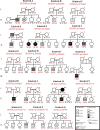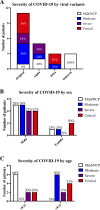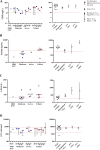Humans with inherited MyD88 and IRAK-4 deficiencies are predisposed to hypoxemic COVID-19 pneumonia
- PMID: 36880831
- PMCID: PMC9998661
- DOI: 10.1084/jem.20220170
Humans with inherited MyD88 and IRAK-4 deficiencies are predisposed to hypoxemic COVID-19 pneumonia
Abstract
X-linked recessive deficiency of TLR7, a MyD88- and IRAK-4-dependent endosomal ssRNA sensor, impairs SARS-CoV-2 recognition and type I IFN production in plasmacytoid dendritic cells (pDCs), thereby underlying hypoxemic COVID-19 pneumonia with high penetrance. We report 22 unvaccinated patients with autosomal recessive MyD88 or IRAK-4 deficiency infected with SARS-CoV-2 (mean age: 10.9 yr; 2 mo to 24 yr), originating from 17 kindreds from eight countries on three continents. 16 patients were hospitalized: six with moderate, four with severe, and six with critical pneumonia, one of whom died. The risk of hypoxemic pneumonia increased with age. The risk of invasive mechanical ventilation was also much greater than in age-matched controls from the general population (OR: 74.7, 95% CI: 26.8-207.8, P < 0.001). The patients' susceptibility to SARS-CoV-2 can be attributed to impaired TLR7-dependent type I IFN production by pDCs, which do not sense SARS-CoV-2 correctly. Patients with inherited MyD88 or IRAK-4 deficiency were long thought to be selectively vulnerable to pyogenic bacteria, but also have a high risk of hypoxemic COVID-19 pneumonia.
© 2023 García García et al.
Conflict of interest statement
Disclosures: C. Flores reported grants from Instituto de Salud Carlos III, Spanish Ministry of Science and Innovation, and Cabildo Insular de Tenerife outside the submitted work. J. Pachlopnik Schmid reported personal fees from University Children's Hospital Zurich and University of Zurich, Switzerland; grants from ITINERARE (University of Zurich, Switzerland), SNF 320030_205097 (Swiss National Science Foundation), and CRPP (University of Zurich, Switzerland); and personal fees from Pharming. J. Pachlopnik Schmid is a member of a data-monitoring committee outside the submitted work. I. Meyts reported grants from CSL Behring paid to the institution and “other” from Boehringer-Ingelheim outside the submitted work. J.-L. Casanova reported a patent to PCT/US2021/04274 pending. No other disclosures were reported.
Figures






Comment in
-
Impact of MyD88 Deficiency on Innate Immune Function in COVID-19 Infection and Allotransplantation.Transplantation. 2023 Oct 1;107(10):2084-2086. doi: 10.1097/TP.0000000000004725. Epub 2023 Sep 25. Transplantation. 2023. PMID: 37749810 No abstract available.
References
-
- Alsina, L., Israelsson E., Altman M.C., Dang K.K., Ghandil P., Israel L., Von Bernuth H., Baldwin N., Qin H., Jin Z., et al. . 2014. A narrow repertoire of transcriptional modules responsive to pyogenic bacteria is impaired in patients carrying loss-of-function mutations in MYD88 or IRAK4. Nat. Immunol.. 15:1134–1142. 10.1038/ni.3028 - DOI - PMC - PubMed
-
- Aluri, J., Bach A., Kaviany S., Chiquetto Paracatu L., Kitcharoensakkul M., Walkiewicz M.A., Putnam C.D., Shinawi M., Saucier N., Rizzi E.M., et al. . 2021. Immunodeficiency and bone marrow failure with mosaic and germline TLR8 gain of function. Blood. 137:2450–2462. 10.1182/blood.2020009620 - DOI - PMC - PubMed
-
- Amorim, V.M., Guardia G.D.A., Dos Santos F.F., Ulrich H., Galante P.A.F., De Souza R.F., Guzzo C.R., Silva De Souza A., Martins De Freitas Amorim V., Guardia G.D.A., et al. . 2022. Severe acute respiratory syndrome coronavirus 2 variants of concern: A perspective for emerging more transmissible and vaccine-resistant strains. Viruses. 14:827. 10.3390/v14040827 - DOI - PMC - PubMed
-
- Asano, T., Boisson B., Onodi F., Matuozzo D., Moncada-Velez M., Maglorius Renkilaraj M.R.L., Zhang P., Meertens L., Bolze A., Materna M., et al. . 2021. X-linked recessive TLR7 deficiency in ∼1% of men under 60 years old with life-threatening COVID-19. Sci. Immunol. 6:65. 10.1126/sciimmunol.abl4348 - DOI - PMC - PubMed
Publication types
MeSH terms
Substances
Supplementary concepts
Grants and funding
LinkOut - more resources
Full Text Sources
Medical
Molecular Biology Databases
Miscellaneous

